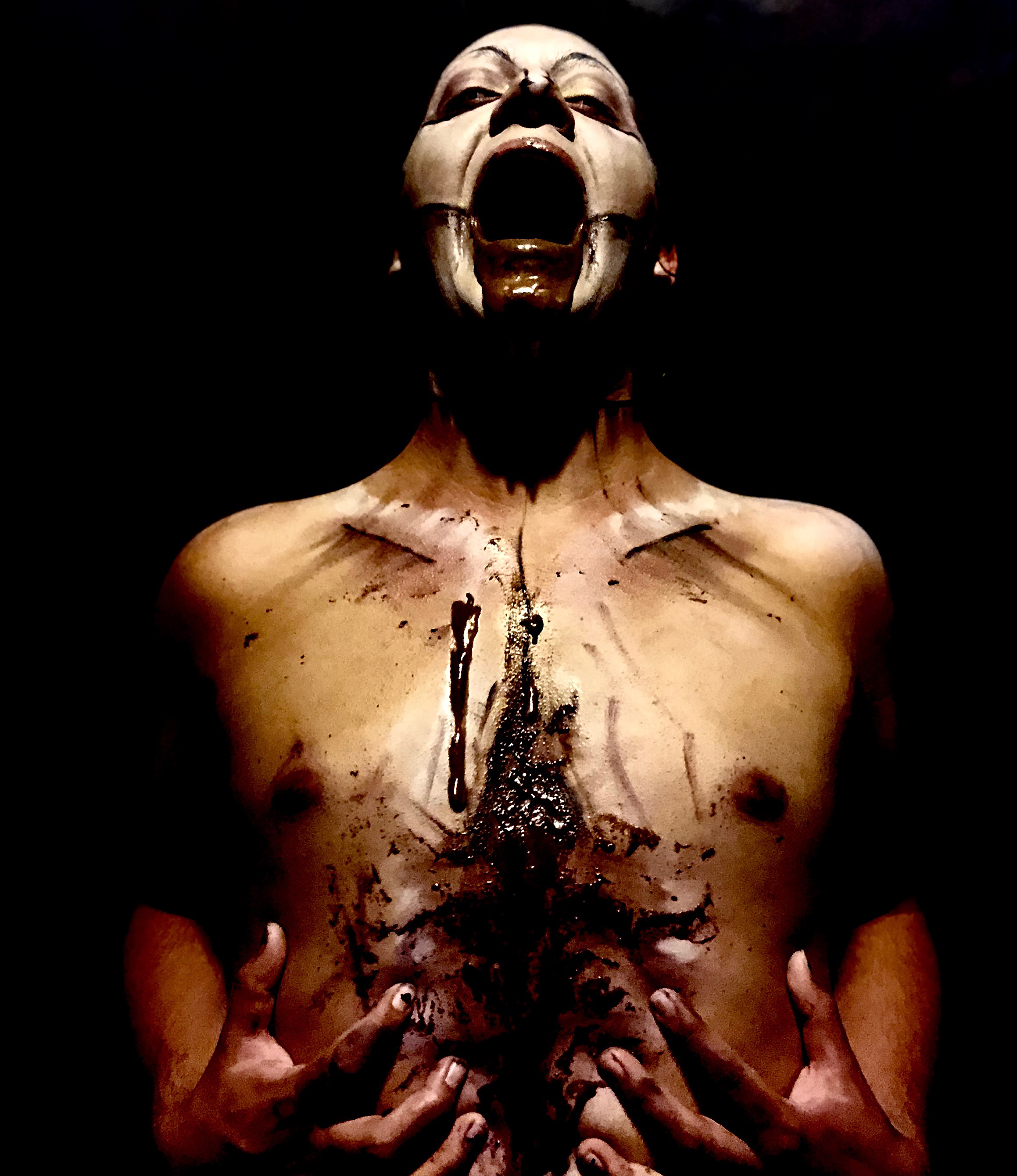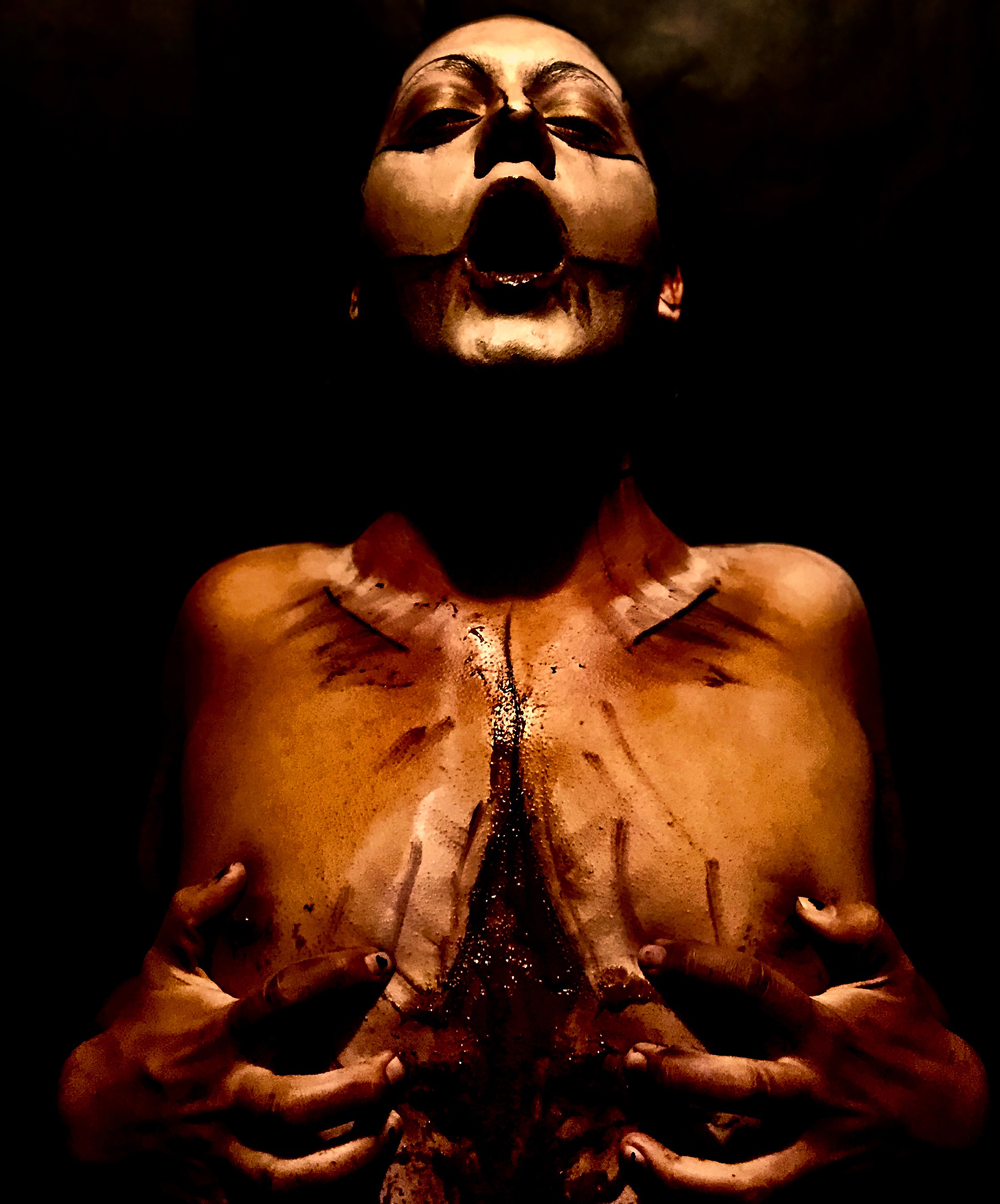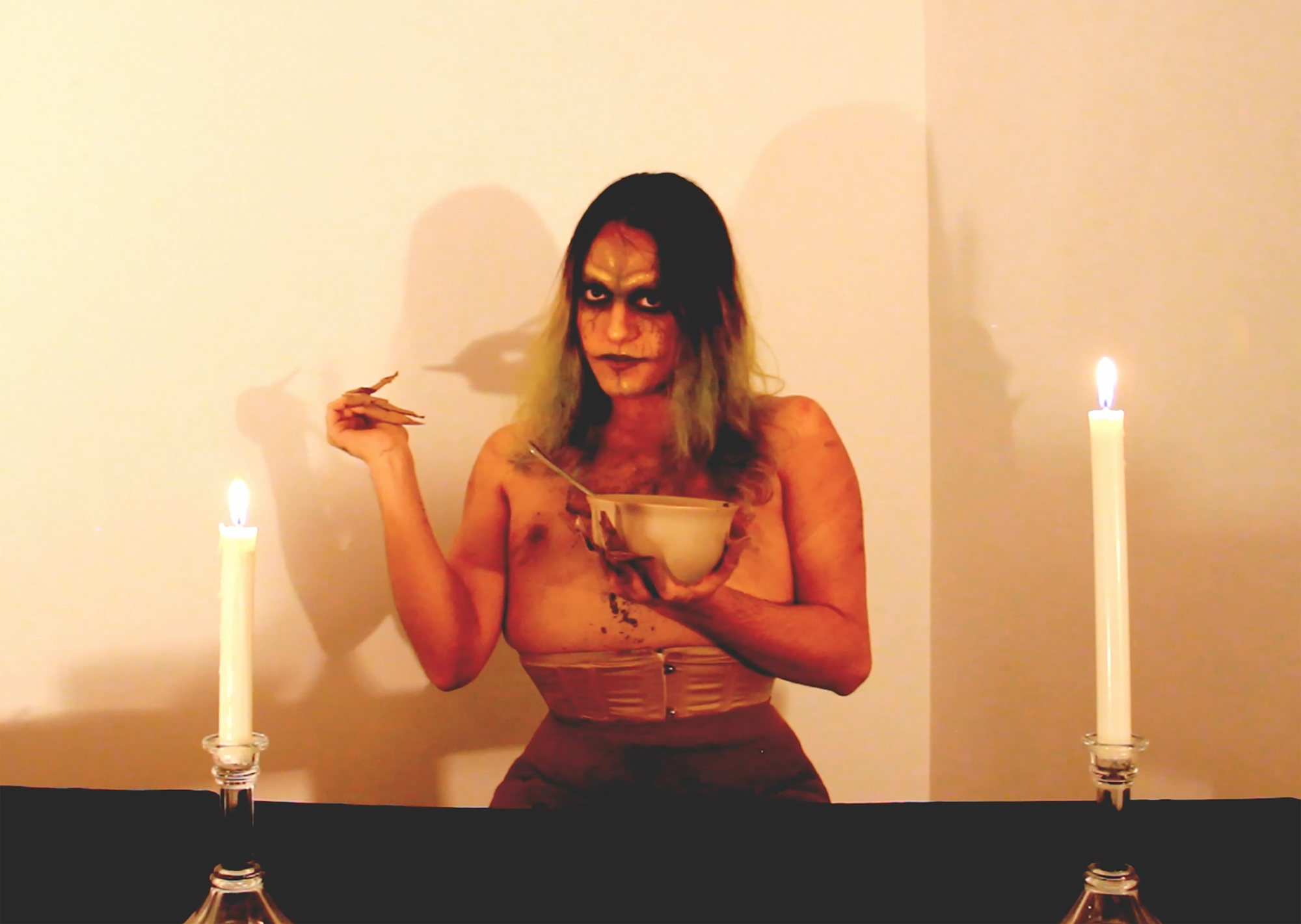
Martin Wannam
-
MARTIN WANNAM & ALEK ZUNIGA DE DOCHAS
In conversation-
︎︎ ︎ ︎︎︎ ︎︎ ︎ ︎
︎ ︎ ︎ ︎ ︎ ︎ ︎ ︎︎︎
︎ ︎ ︎︎ ︎︎︎︎ ︎︎ ︎
Martín Wannam: Hi Alek! Hope you’re doing amazing and that you had an amazing art review!!!! So for starters talk to me about who you are and your art-making.
Alek Zuniga De Dochas: Martín!! Same to you, dearest, thank you. And yes, my review went as well as I could have hoped amidst the restrictions & uncertainty of the pandemic, haha.
I’m a trans-femme latinx artist, educator, and resident mud monster in the enchanting desert of Albuquerque, NM. I make work about the dark parts of the earth that are sometimes hard to stomach; the exploited, the disfigured, the violated, the queered, the othered. Specifically, I tend to look at the U.S. and its history of violence against the earth and its inhabitants. Lately I’ve been making a lot of films & performances with my alter ego, the Dryad, but generally speaking my media is dependent upon the project at hand. In short, I’ve just been making various messes in art and academia for years now, and hoping that every once in a while one of those messes will stick and become something more compelling.
I’ll flip your question right back onto you. Who are you, Martín? And then, could you talk to me about your latest body of work, La Eterna Resistencia and what it means to you? Your exhibition at the CFA Downtown Studio last Spring was so vibrant but also haunting and heavy in many respects. I’m grateful that I was able to experience it before lockdown began.
Martín: I'm so glad that the review went well regardless of the uncertainty of the pandemic.
Well, I'm a Guatemalan artist/educator currently residing in Albuquerque NM. Overall, my work artistic addresses the human rights abuses towards the LGBTQI+ community in Central America, imperialism history, and constant evaluation of systems of oppression. As you may know my primary medium has been photography but since moving away from Guatemala I have been using performance and sculpture as a way to protest crimes against our community based on ideals imposed by state, religion, and society.



Alek Zuniga De Dochas
Yes, La Eterna Resistencia or in English “The Eternal Resistance” is project that looks critically at the social and political climate of Guatemala, specifically examining its impact on the queer bodies. The work exposes my political stands as a queer person of color to the different types of violence enacted by the state and the culture. I casted a baby Jesus in white chocolate to eat it and spit it out in front of the Catedral Metropolitana del Apóstol Santiago de Guatemala to talk about white supremacy. I made someone carved the word “Hueco”, that means Fag, in front of the national palace to protest the violent hate crimes arising in 2019. I created over a 100 red wax bananas to talk about the genocide that the USA basically funded.. I took legends that are already deeply embedded, and I develop my own, inspired by members of my community. And finally, I burn a piñata of your current president. Jajajajaja, I got a little intense but that how I feel about my work rn.
So Alek, I think that both of our works have a common intersection: queerness, performance & USA bloody history.No? But I want to start with to ask you about your alter ego: The Dryad. Tell us more about this persona and how do you produce work in the intersection of queerness and ecology.
Alek: There is so much rich symbolism and subtext in your imagery, but even without having the full context behind one of these works, I think that audience members can pick up on their meaning just through the visual weight of them. The intensity is felt, and in my opinion it’s completely appropriate to the times we’re in. So keep on burning shit, haha.
Our practices definitely intersect in the ways you mention. My queerness paints the lens that I use to work through these heavy issues. I told you at your opening reception, but the portrait series you created of your community members embodying different legends really got me excited, specifically because of the work I’ve been doing with the Dryad. This character has conjured itself into my work for the past few years now and it has acted as a sort of embodiment of the earth but in the most disastrously queer ways. It’s a complete bastardization of the well-accepted concept of a dryad from Greek mythology and popular culture. It’s not a fairy-like wood nymph, a serene and romantic spirit in some distant grove--my Dryad is instead more akin to a reanimated corpse, an amalgamation of mud & viscera given form from the bones of the earth in order to engage with humanity. The Dryad is the product of centuries of western imperial violence on all of the earth’s most vulnerable life forms--both human and nonhuman--and is subsequently rather unstable and at times unsightly. I’m really interested in thinking about the ways that the Dryad might try and adapt to emerging in the 21st century in order to reach audiences. The results have been absurd, comical, erotic, completely alienating, and at times downright unwatchable. If you’ve never seen a primordial mud monster put on a corset and film a politically-motivated mukbang, can you really say you understand the climate crisis? Haha.
The earth is arguably the most consequential queer body known to humanity, and it’s been thrilling and curious and devastating to explore the ways that this can be expressed visually through my work with the Dryad.
You and I have joked about the differences between us and our aesthetics; for instance, my studio walls tend to be covered in dirt while your old studio still has glitter caked into its crevices. But honestly, there’s a lot of dialogue between our art practices. I might be the messy horror queen, but your work has made my hair stand on end because of how chilling and gut-wrenching it was. The Hueco piece in particular is still so hard for me to endure. How do you view the relationship between these really powerful, visceral visuals with the sometimes loud, energetic colors and forms you utilize?


Alek Zuniga De Dochas
Martín: Ugh Alek I love the deep thinking behind the Dryad, mostly the way that you framed it as an antithesis of what people expect from queerness. I feel most people will not realize that queerness is a mess, is horror, and is FUCKING glamorous at the same time ( Dragula reference). Using the Dryad to explore the violence that not just the body but the earth has gone through from the western work is really powerful.
Lol PERIOD on the glitter! But I would add that it’s mostly pink. Well in particular with the “Ser Hueco en mi Pais” I was reacting to what was happening in my country and felt the need to act. Sometimes those reactions tend to replicate the violence that we, as queer people, are subjective in a country that will not recognize our rights. To me that work show you the cruel reality of my community; but what would one be as a human if hope is lost? My work also images utopia, the horizon that I imagine… the horizon that we deserve. Creating a balance of what I present is vital to my vision and to get through the viewer, specialty my viewers from America Latina, as I show the fuck up reality with a taste of hope.
Correct me here if I’m wrong but we both have experience making people really uncomfortable by presenting our work to specific audiences. For instance, your performance “DRYAD EATS IMPERIAL BULLSHIT” embodies to me all of what queer stands for its beautiful, political, horrific, comedic, and will make some viewers feel uncomfortable. Would you say that’s one of your goals? I would also love to know more about this amazing performance and the use of your alter ego as a political tool.


Martin Wannam
Alek: That balance that you describe is important to me as well. It might not seem like it at first glance, but hope is crucial to my work. I wouldn’t say that I strive towards the utopia that you’re imaging in your practice, but I am presenting potential futures to audiences and hoping they’ll choose one where we don’t continue killing ourselves and our planet. Part of that process of urging viewers to take action, to participate in a better tomorrow, does involve filling them with a sense of discomfort. That piece you mentioned involves the Dryad consuming a bowl full of unidentifiable black sludge, and it’s filmed as if it’s being performed for an online audience; like the Dryad is some sort of demented influencer for the dark web reviewing this foul dish of imperial bullshit. The content of the film and the way it’s edited is meant to be disorienting--moving from feelings of repulsion to seduction to impish hysteria repeatedly over the course of six minutes. Viewers get a string of strong sensations aroused in them, and all surrounding this very blatant undermining of imperialism. I think that’s becoming more important to me with this character...not only for it to represent the queer body of earth in all of its horrific glory, but also to be a decolonial court jester of sorts that jabs incessantly at these violent power structures.
Your work challenges systems of violence & oppression in a way that uplifts queer people of color, especially in your community back home in Guatemala. I know I’m circling back, but I’m just a bit obsessed over the legend portraits--La Llorona, La Monoxide, La Cadeja to name a few--and I’m wondering if you could put to words what it means to you to portray these individuals in this way. Do these images criticize colonial ideology in the same way that your other work does?
Martín: Yes for sure, the legends portraits, inspired by my interpretation of the legend. I make these portraits in public spaces throughout Guatemala City (cemeteries, bars, public pools, parks, and construction places), with the intention to give a contemporary context and visual representation to folklore that only lives in oral tradition. I use the creation of new narratives with the intention to create new representations of diverse individuals within my community, broadly, in deliberate opposition to the media that still pushes for a western model of beauty. In “queering” these legends by intentionally changing the characters’ genders and stories, and integrating drag culture, I intend to both disrupt something familiar and at the same time propose something unfamiliar, to clash comfort zones and create new representation. Why are all of these legends based on heterosexual worldviews? Disrupting that normative model brings me to the question of: If Guatemalan legends were based on, or honored, queer characters, would hate and violence towards the community exist, as it does today?
The images at their core do criticize colonial ideology, as the legacy of the gender binary comes from the western world. And they work as a gesture to dismantle those colonial structures in our world today. I think that proposing the queer body as a political weapon to destabilize, dismantle, and reflection over power structures like imperialism is needed right now. The use of the body as a political tool is present in your work at all times, including the mud drawings, could you talk a little about the play between your materiality and the body present in your work? How does it relate to imperialism?
Alek: That’s a powerful statement--that we can use our queer bodies as weapons to destabilize harmful systems. I see that enacted so gracefully and decisively in your studio practice, across all media and processes. That’s definitely something that I try to invoke in my work as well; if the very act of me breathing as a trans latinx person is political, I might as well make a damn statement while I’m at it!!! In a lot of my performance & film especially, my body is being subjugated to something revolting or violent, and viewers are then implicated in that act. If an audience member sees me being force fed black slime or gorging myself on this or that foreign substance, they more than likely respond with a desire to help me or to bring the act to an end--even when I’m wearing the twisted otherworldly faces of the Dryad. This innate compassion for the Other is what I’m yearning for in my work. For someone to see a person, a plant, an animal, a queer mud monster or what have you--something so apparently alien or far from themselves--and to sympathize with that lifeform, to be compelled to help them. That type of radical care is inherently anti-imperial and anti-capitalist.
The materials that I interact with become characters themselves, collaborators in the work, with their own volition, complexity, and power. The more-than-human is significant to the decolonial framework that I approach these issues through, and I want audiences to acknowledge the vitality of matter and lifeforms beyond the scope of western value systems. Your practice has become very multidisciplinary in recent years, and you’ve been engaging with media of all kinds. What is your relationship to the materials you’re working with as of late, and what does the future of your practice look like in your mind? Is it filled with more wax and chocolate, flaming piñatas and flesh carvingz.



Martin Wannam
Martín: Indeed, my practice has slowly become multidisciplinary with less and less emphasis on the photographic medium, as such a medium rooted in white supremacy. I have been working a lot with different types of sculpture & performance that include materials that are familiar to my culture, things that I grow up with, that have their roots in coloniality… but basically LATINE. I think sometimes I felt limited by photography, I still love it but that’s the true T.
In terms of my future in materiality and my art practices I see a lot of wax and performance… That's the plan but you know sometimes it changes. I want to go back home soon to do more work, and by the looks of the political climate I will be there shortly.
Alek, we are getting to the end of this beautiful double lip sync for your legacy, but I want to ask: What's next for you friend?
Alek: Hahaha, I can’t with you… I plan on making more messes. I’m currently working on the prologue for a Dryad graphic novel, so hopefully there’s more to tell on that sometime soon. More videos and performances are sure to sprout up as well.
Thank you for chatting with me, Martín, this was lovely! I always feel more inspired and full of creative energy after we talk. I can’t wait to see what lies ahead for you in art and in life.
Let’s grab a socially-distanced drink together soon. <3
____
Alek Zuniga de Dóchas (b. 1995) is a trans-femme latinx creative worker and interdisciplinary artist whose practice responds to imperial and colonial violence on the earth and its inhabitants through a wide range of media including performance, film, installation, and illustration. A large body of work surrounds Zuniga de Dóchas’s mythical alter ego, the Dryad, and their existential journey as a queer embodiment of the earth during the late stages of capitalism and western colonialism. Through the means and material available to them, Zuniga de Dóchas hopes to cultivate a sense of solidarity and kinship across different forms and walks of life, and to challenge western notions of social, political, and economic value.
Zuniga de Dóchas attended Pacific Northwest College of Art (Oregon) and Boise State University (Idaho), graduating with a BFA in Visual Art at the latter institute in the Spring of 2018, and they are currently a candidate in the University of New Mexico's MFA Art & Ecology program. Their work has been exhibited and published nationally from coast to coast, and they have performed in internationally-exhibited and award-winning films.
Martin Wannam (b. 1992, Guatemala) is a visual artist whose work utilizes photography, performance, and sculpture to disrupt the meaning of religion, folklore, and western beauty standards. Through the critical lenses of history, gender, sexuality, and race he challenges his own cultural background and deconstructs and disrupts the hegemony of religion as his own gesture of political resistance.
He received his MFA in Photography from the University of New Mexico in the Spring of 2020, a diploma in contemporary photography from La Fototeca (GT) in 2016, and their BA in graphic design from the Universidad Rafael Landivar (GT)in 2015. Wannam has exhibited nationally and internationally, including various group and solo shows in the United States, Guatemala, Rotterdam, and Paris. Wannam is the recipient of a Fulcrum Fund 516 Arts (2020), MaryAnn Evans Grant (2019), SPE Student Award for Innovations in Imaging (2018), and is a SITE Scholar (2018-2019).
